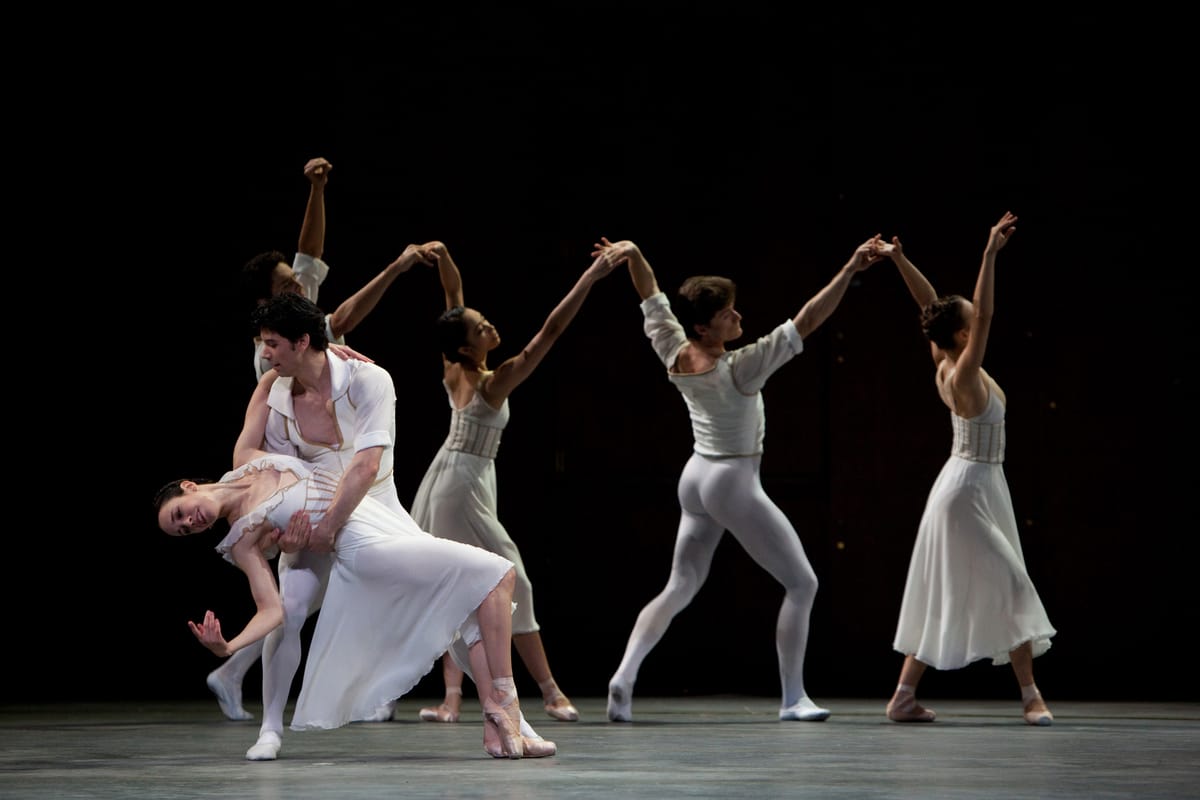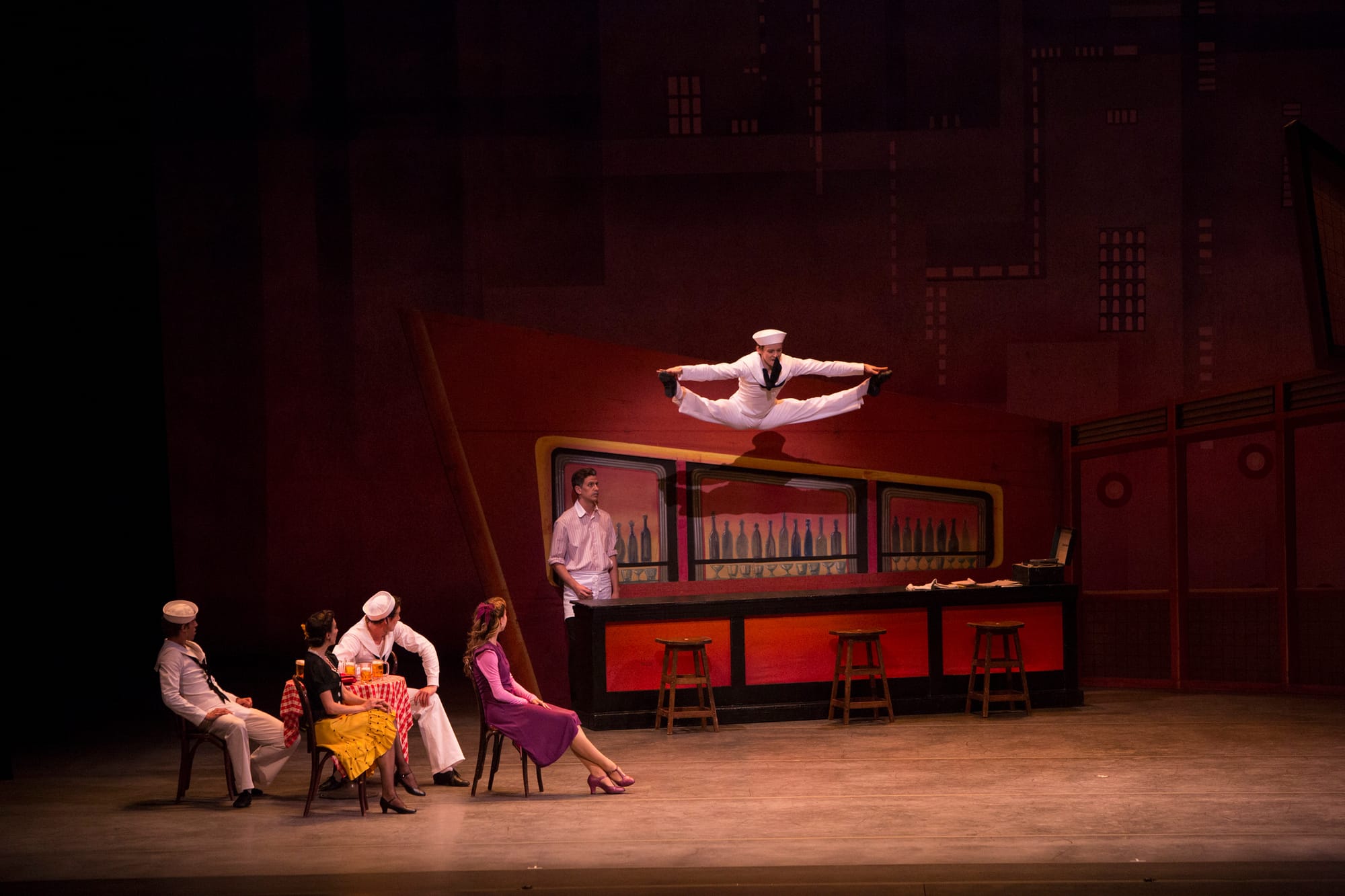Princes and Sailors and Ordinary People

"Raymonda Divertissements", "Seven Sonatas", "Fancy Free"
American Ballet Theatre
David H. Koch Theater
New York, NY
October 25, 2014, matinee
Variety is one of the benefits of ABT's fall season--the collection of one-act works don't have to be programmed in blocks, so it is possible to see the ballets in various arrangements. The Saturday matinee opened and closed, like the opening night performance, with "Raymoda Divertissements" and "Fancy Free", but the middle work was the modern, plotless "Seven Sonatas" instead of Wednesday's dramatic "Jardin aux Lilas". The casting, too, was new, with several debuts. Gillian Murphy and Alexandre Hammoudi were the new couple in "Raymonda Divertissements". Murphy danced stylishly and confidently, seeming to let that luscious music pull the steps out of her. She has always been a fearless technician but her dancing has developed a luxurious patina and a majestic, three-dimensional quality; there is a stateliness about her upper body that suits Petipa's glorious, ideal women. She did eschew the audible claps in the solo, unfortunately, barely bringing her fingers together. I know this is the current Russian style, but in an interview Freddie Franklin said that he had learned "Raymonda" from Alexandra Danilova, who knew the Petipa production, and that Raymonda's solo had an audible clap. For me, this gives the performance a unique and distinctive snap, though even without it, Murphy's solo ravishing combination of openness, as she bourréed towards the audience with her arms seeming to offer them joy, and mystery, as she seemed be pulled inwards by that intoxicating music.
Alexandre Hammoud is a tall, handsome dancer with a smoldering presence. He is not exceptionally strong technically, but is a warm and gracious dancer with the intelligence not to push against his limitations, and danced his solo with real flair. Cassandra Trenary and Devon Teuscher danced the two difficult female solos confidently and stylishly. This production has doubled up one of Petipa's solos, here danced by Nicole Graniero and Luciana Paris; the sister act means the dancers must concentrate more on synchronization than musicality, and though each dancer shimmered in the flickering little steps, the timing was a bit off. The bravura male pas de quatre (Sng Woo Han, Blaine Hoven, Calvin Royal, and Joo Won Ahn) had better timing than the opening performance, and I especially liked Royal's warm acknowledgement of his fellow dancers; even his sightly botched ending didn't faze his smile.
Royal also danced in Alexi Ratmansky's "Seven Sonatas", to piano music by Domenico Scarlatti. It could also be called "More Dances at a Gathering", as the six dancers in white (flowing chiffon for the ladies) danced in various combinations backed by an on-stage piano. The dancers (Royal and Stella Abrera, Xiomara Reyes and Herman Cornejo, and Julie Kent and Joseph Gorak) were variously playful, flirtatious and contemplative as they related to each other and to the music. There was no narrative, though there were hints of dramatic undercurrents, especially in the long pas de deux for Royal and Abrera, full of stretching, pointing gestures and sudden leave-takings; it had an elegiac restlessness.
Reyes and Cornejo were more playful and their pas de deux was full of quick little steps. Cornejo was wont to abandon Reyes mid-move, but this seemed like a picture of a young man's short attention span, not a guide for living. Kent danced with a gentle urgency, while Gorak, in the part choreographed for David Hallberg, showed a quiet and magnificent control, flowing through his jumps. Ratmansky's choreography shows off the dancers' physical gifts, but he also lets their individuality shine, a rare and welcome gift. But by the end, I couldn't help but think of Dr. Johnson's comment on "Paradise Lost"--"none wished it longer".

Plenty of people wished that "Fancy Free" were longer, and they turned it into a Broadway musical. The original, though, is always welcome and this performance saw the New York debuts of Eric Tamm as the middle sailor and James Whiteside as the swaggering rumba dancer, accompanied by Daniil Simkin. They made a fine trio. Tamm had a corn-fed innocence and gave the pas de deux an appealing hesitancy. His solo had a quiet intensity that glowed between the two more bravura performers. Simkin's youthful face and slight frame work perfectly for the first sailor as he tried to keep up with the big boys. (Not that he had to try that hard, since he flew through his solo.) Whiteside's extroverted persona suits the third sailor, but this performance was much more than a chance to strut his stuff, as he gave a true warmth to his relations with his buddies.
Luciana Paris was the girl with the red pocketbook, and for me, she made her a bit too fearful and anxious, giving the opening vignette a slightly ominous tinge which works against the usual playful high-jinx, though her final exasperation when the sailors chose to fight rather than switch was very funny. Isabella Boylston danced the pas de deux, and again, she made it more serious than Julie Kent's arch Bronx princess approach. Boylston was a young girl looking for love, and she seemed to auditioning for Juliet, though again, her final flounce out was very well done.
copyright © 2014 by Mary Cargill



